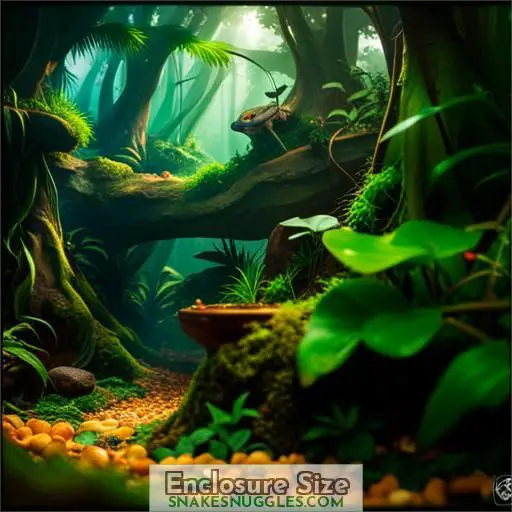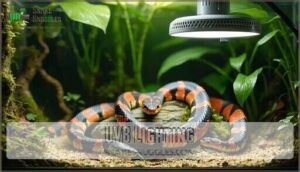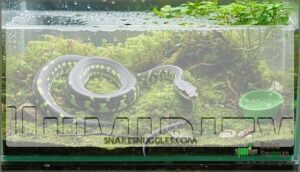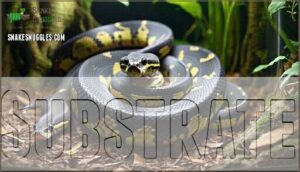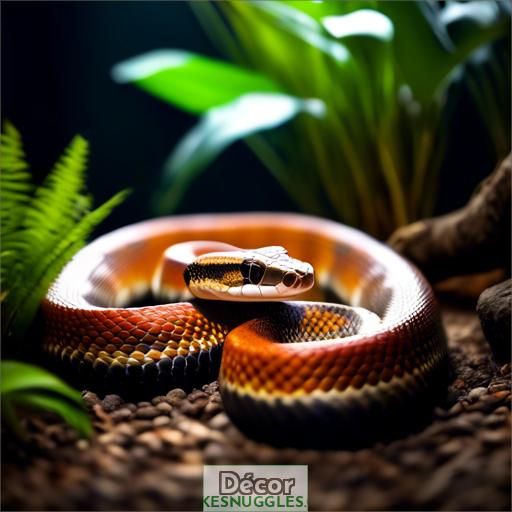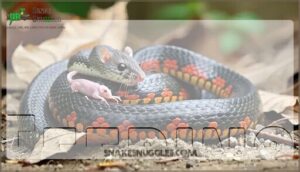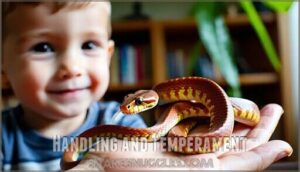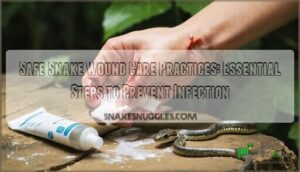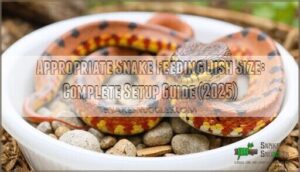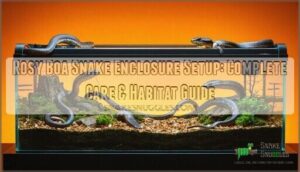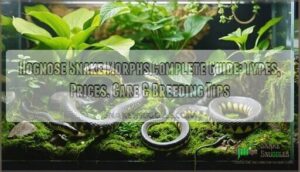This site is supported by our readers. We may earn a commission, at no cost to you, if you purchase through links.
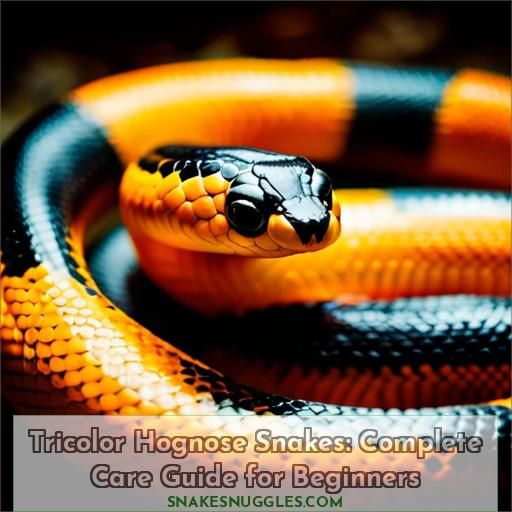
To properly care for a tricolor hognose snake, you’ll need an enclosure at least 30 inches long, 12 inches wide, and 12 inches tall. Include a front-opening for easy access and a substrate guard to prevent escape.
UVB lighting, though not strictly necessary, provides important health benefits. Maintain a basking temperature of 90-95°F and a cooler side of 72-82°F using a halogen heat lamp.
Humidity should average 30-50%, with a humid hide. Use a 3+ inch substrate like aspen or cypress.
Proper tricolor hognose care requires attention to every detail.
Table Of Contents
Key Takeaways
- Tricolor hognose snakes need an enclosure that’s at least 30 inches long, 12 inches wide, and 12 inches tall, with a front-opening for easy access and a substrate guard to prevent escape.
- UVB lighting, while not strictly necessary, provides important health benefits and can be placed on the same side as the heat lamp.
- Maintain a basking temperature of 90-95°F and a cooler side of 72-82°F using a halogen heat lamp.
- Humidity should average 30-50%, with a humid hide to aid in shedding and hydration.
Enclosure Size
You’ll need to provide a proper enclosure for your tricolor hognose snake.
A front-opening terrarium with a minimum size of 30L x 12W x 12H is required, but larger enclosures are preferred to allow for proper thermoregulation and burrowing.
A substrate guard of at least 4 tall is essential to prevent ingestion.
Cohabitation with other snakes isn’t recommended due to the risks of stress and potential aggression.
Minimum Size
Regarding the enclosure size for tricolor hognose snakes, consider these guidelines for effective care:
- Minimum Size: A single adult tricolor hognose requires an enclosure of at least 10 gallons, ideally 20 gallons.
- Front-Opening: The enclosure should have a front-opening for safe access, with a substrate guard at least 4” tall to prevent escapes.
- Substrate Guard: A substrate guard is crucial to deter the snake from burrowing too deep and escaping.
- Cohabitation: Tricolor hognose snakes are solitary creatures and should be housed independently to avoid stress and potential aggression.
Preferred Size
Important size is vital for the well-being of your tricolor hognose snake. While the minimum enclosure size is 30 inches long, 12 inches wide, and 12 inches high, it’s recommended to provide a larger space for your pet. A larger enclosure allows your snake to move around freely, which is essential for their physical and mental health.
To create a favorable environment for your tricolor hognose, consider a 36-inch-long, 18-inch-wide, and 16-inch-high enclosure. This size provides ample space for your snake to burrow and explore, ensuring they feel secure and comfortable.
When selecting an enclosure, consider the following factors:
- Substrate depth: Tricolor hognose snakes are fossorial, meaning they burrow in the substrate. A minimum substrate depth of 3 inches is recommended.
- Hiding options: Your snake will need hiding places to feel secure. Provide hiding spots around the enclosure, such as leaf litter, caves, or sturdy branches.
- Lighting placement: UVB lighting should be placed on the same side as the heat lamp, and the bulb should be about half the length of the enclosure.
- Handling: Tricolor hognose snakes can be handled, but they may exhibit thrashing behavior until they become accustomed to your touch.
- Feeding: Neonate tricolor hognoses start on frozen/thawed pinkie mice, while young snakes work up to f/t adult mice by adulthood.
- Prey: In the wild, tricolor hognoses eat amphibians, lizards, and reptile eggs. Replicate this diet in captivity with frog and anole Reptilinks, button quail chicks, and quail eggs.
Front-Opening
Front-opening enclosures are highly recommended for tricolor hognose snakes. This design allows for easy access to the enclosure and reduces stress for the snake. Here are four key points to keep in mind when choosing a front-opening enclosure for your tricolor hognose snake:
- Door Design: A front-opening door should be sturdy and secure, with a lock or latch to keep the snake contained. Some enclosures come with magnetic doors that can be folded and stored when not in use.
- Hinges: High-quality hinges are essential for a secure and durable enclosure. Look for enclosures with heavy-duty hinges that can withstand the weight of the snake and the enclosure.
- Sliding Doors: Sliding doors can be a convenient option for front-opening enclosures, as they allow for easy access without disturbing the snake’s environment.
- Lock Strength: Make sure that the lock on the front-opening door is strong enough to prevent the snake from escaping. A secure lock is vital for the safety of both the snake and the owner.
When selecting an enclosure, take into account the size, material, and features that best suit your tricolor hognose snake’s needs. Remember that a larger enclosure with a front-opening door is preferred, as it provides more space for the snake to move and explore.
Substrate Guard
Ensuring your tricolor hognose’s home is a fortress of comfort starts with the right substrate guard. It’s not just about keeping the sandy soil in; it’s about creating a microclimate where temperature and humidity levels are just right, mimicking their natural habitat. This little touch can make a world of difference, ensuring substrate moisture remains optimal, and cleanliness is a breeze. Remember, a happy snake is a healthy snake, and it all begins beneath their belly.
| Substrate Depth | Substrate Replacement |
|---|---|
| At least 3 inches | Every 3-4 months |
| Substrate Types | Substrate Cleanliness |
| Aspen, Eco Earth | Daily poop and urate removal |
Cohabitation
Cohabitation is a subject that arises frequently in discussions about tricolor hognose snake care. While these snakes are generally solitary animals, there are instances where they can be kept together. However, it’s imperative to comprehend the risks and benefits of cohabitation, as well as the legal and safety considerations.
Cohabitation risks include the possibility of aggressive behavior, cannibalism, and the spread of diseases. For example, if one snake isn’t feeding well, it may prey on its cohabitant, leading to stress and potential harm. Additionally, if one snake is carrying a disease, it can easily transmit it to its cohabitant.
On the other hand, cohabitation can have benefits. For instance, it can help reduce the cost of maintaining multiple enclosures and can provide a more natural environment for the snakes, as they’re social animals in the wild. However, it’s critical to guarantee that the snakes are well-fed and healthy to minimize the risks associated with cohabitation.
Alternatives to cohabitation include keeping the snakes in separate enclosures or using a larger enclosure with multiple hides and hiding places. This approach allows the snakes to have their own space and reduces the risk of aggressive behavior and cannibalism.
In terms of legality, cohabitation is generally not recommended by experts due to the risks involved. It’s essential to verify with local and state regulations regarding reptile ownership and cohabitation.
To guarantee the safety of the snakes during cohabitation, it’s critical to monitor their behavior closely and separate them if any aggressive behavior is observed. It’s also essential to provide plenty of hiding places and a temperature gradient to allow the snakes to thermoregulate.
UVB Lighting
UVB lighting isn’t strictly indispensable for tricolor hognose snakes as they can subsist without it.
Nonetheless, providing suitable UVB illumination is regarded as best practice and assists in fostering ideal well-being.
It enables effective vitamin D3 synthesis, bolsters immune function, and facilitates digestion.
The recommended UVB bulbs are the Arcadia ShadeDweller kit, Arcadia T5 HO Forest 6%, and Zoo Med T5 HO Reptisun 5.0.
Situate the UVB lamp on the same side as the heat lamp, extending approximately half the length of the enclosure.
Replace the bulb every 12 months.
Survival Without UVB
Tricolor hognose snakes can survive without UVB lighting. However, it is advisable to provide it for maximum health and well-being.
These snakes are active during the day. They can gain from exposure to UVB light, which is vital for the production of vitamin D3. Vitamin D3 plays a key role in the immune system, calcium absorption, and overall health.
UVB lighting can also help maintain the natural day-night cycle. This can improve the snake’s mood and activity levels.
Best Practice
UVB lighting is essential for tricolor hognose snakes to flourish in captivity. Although they can survive without it, providing UVB lighting is the recommended practice for their health and wellbeing. Here are three key points to bear in mind:
- Burrowing Behavior: Tricolor hognose snakes are fossorial, meaning they spend a significant portion of their lives underground. UVB light helps stimulate their natural burrowing behavior and encourages them to come out and explore their enclosure.
- Substrate Moisture: UVB light promotes substrate moisture, which is vital for the snake’s health and hydration. It also helps maintain the humidity levels in the enclosure, ensuring the snake’s skin remains moist and healthy.
- Enclosure Ventilation: UVB light helps improve enclosure ventilation by encouraging the snake to move around and create airflow. This is important for maintaining a healthy environment and preventing respiratory issues.
When providing UVB lighting, use a reflective fixture such as Arcadia or Vivarium Electronics. Position the lamp on the same side of the terrarium as the heat lamp, and position the basking surface/branch so the snake’s back is an appropriate distance from the lamp, depending on the bulb. Replace the bulb every 12 months.
Best UVB Bulbs
The best UVB bulbs for tricolor hognose snake care include:
The Arcadia ShadeDweller kit
The Arcadia T5 HO Forest 6%
The Zoo Med T5 HO Reptisun 5.0
These bulbs provide the necessary UVB for:
A day/night cycle
Vitamin D production
Immune system support
Aiding digestion
Place the lamp on the same side as the heat lamp, half the length of the enclosure.
Replace the bulb every 12 months to guarantee maximum benefits.
Placement
After selecting the most suitable UVB bulbs, it’s imperative to position them strategically in your tricolor hognose’s enclosure in order to replicate its natural environment. Here’s how:
- Place near rocks and vegetation
- Above branches for sunbathing
- Guarantee sufficient substrate depth
- Establish a moisture gradient
- Prevent direct contact with water
Replacement Frequency
Replacing your UVB bulb is essential for creating the ideal environment for your tricolor hognose snake.
A helpful guideline is to change the bulb every 12 months, as its effectiveness diminishes over time.
This guarantees that your snake receives the necessary UVB light for vitamin D production, immune system enhancement, and digestion.
Remember to cut power to the fixture before removing or installing the bulb to maximize the fixture’s life.
Heating
For proper thermoregulation, you’ll want to provide a basking surface temperature of 90-95°F and maintain the cool side between 72-82°F. Use a halogen heat bulb positioned on one side of the enclosure, avoiding ceramic heat emitters, heat mats, red or blue bulbs. Heating should be turned off at night to allow for a temperature drop.
Basking Surface Temperature
To guarantee your tricolor hognose flourishes, it’s vital to maintain the appropriate basking surface temperature.
Strive for 90-95°F (32-35°C) using a halogen flood heat bulb positioned on one side of the enclosure.
Measure temperatures with an infrared thermometer, and cease heating during nighttime hours.
The cool side should hover between 72-82°F (22-28°C).
Utilize naturalistic substrates such as Zoo Med Eco Earth or Exo Terra Plantation Soil to maintain a temperature gradient.
Cool Side Temperature
Regarding the cooler section of a tricolor hognose snake’s habitat, the recommended range is between 72-82°F (22-27°C). This range is critical for preserving the snake’s overall health. The cooler area should offer a comfortable resting and digesting environment, as well as a means of regulating body temperature when moving away from the basking spot.
It is essential to monitor and maintain this temperature range to promote the snake’s well-being. This can be achieved using a digital probe thermometer placed on the cooler end of the enclosure to accurately measure the temperature. The thermometer will assist in tracking and adjusting the heating setup to maintain the desired range.
It is also important to consider that the cooler side temperature may fluctuate slightly based on seasonal variations and the humidity gradient within the enclosure. For instance, during the day, the cooler side may be marginally warmer due to the snake’s burrowing behavior, while at night, the temperature may descend to the lower end of the range. This is an inherent part of the diurnal cycle and should be anticipated, however, it’s imperative to prevent the temperature from falling below the lower limit of the recommended range.
Heat Lamp
To provide adequate heating for your tricolor hognose snake, you should use a halogen heat bulb placed on one side of the enclosure.
This bulb should be positioned over a large, flat stone placed on top of the substrate.
The wattage of the bulb will depend on the size of your enclosure and the distance between the light and the basking surface.
A pair of 50w halogen flood bulbs like the Arcadia Halogen Heat Lamp is a good starting point.
However, you may need to adjust the wattage to achieve the desired temperature gradient.
Heating Turn-Off
To safeguard the well-being of your tricolor hognose snake, it’s imperative to establish the necessary temperature gradient within its enclosure. This encompasses both the basking area and the less warm side of the enclosure. The following table provides a visual representation of the recommended temperature ranges:
| Temperature Range | Description |
|---|---|
| 90-95°F | Basking surface temperature |
| 72-82°F | Cooler side temperature |
| 65-75°F | Nighttime temperature |
For a tricolor hognose snake, the basking surface temperature should range between 90-95°F, while the cooler side temperature should be between 72-82°F. Nighttime temperatures should be maintained within the range of 65-75°F, with a temperature decrease to simulate its natural habitat. All heat sources should be controlled by a thermostat, and heating should be deactivated during the night to facilitate a natural temperature drop and promote a healthy circadian rhythm.
When setting up the heating system, it’s essential to employ halogen flood heat bulbs positioned above the basking area, such as a piece of flagstone or stone paver. Don’t use ceramic heat emitters (CHEs), red bulbs, or blue bulbs, as these are less effective. To ascertain the temperatures within the enclosure, utilize an infrared thermometer for surface temperatures and a digital probe thermometer for local air temperatures.
Heating Materials
For your tricolor hognose, ditch ceramic heat emitters, heat mats, red and blue bulbs. Opt for halogen heat bulbs, mimicking the warmth of their native North American habitats.
Humidity
Maintaining appropriate humidity levels is paramount for the well-being of your tricolor hognose snake. Strive for an average humidity range of 30-50%, offering a moist hide with dampened substrate to aid in shedding and guarantee your snake remains hydrated.
Average Humidity
Maintaining appropriate humidity levels is vital for the health and well-being of your tricolor hognose snake. The ideal humidity range for these snakes is between 30-50%, which can be measured using a digital probe hygrometer. To establish proper humidity levels, create a humid hide – a high-humidity hole where the snake can shed comfortably. Monitor the enclosure’s humidity consistently throughout the day using a hygrometer.
During shedding, you may need to moisten the substrate on the cool side of the enclosure to maintain higher humidity levels. Additionally, providing a water dish can help maintain humidity levels and fulfill the snake’s drinking requirements.
Remember to monitor the humidity regularly and adjust as necessary to ensure your tricolor hognose snake is comfortable and healthy.
Humid Hide
To create a humid hide for your tricolor hognose snake, consider these four items:
- Moistened substrate: Provide a moistened substrate, such as sphagnum moss, in a section of the enclosure for your snake to use as a humid retreat.
- Hiding places are crucial for your Tricolor Hognose snake’s stress reduction and overall well-being, and you can create unique, species-specific hides by exploring various DIY snake hide ideas. Add logs, small caves, or DIY hiding places made from plastic boxes and containers to give your snake a variety of hiding options.
- Burrowing medium: Use a naturalistic substrate that’s at least 3 inches deep to allow your snake to dig and burrow, which is essential for their natural behavior.
- Sphagnum moss: Line the humid hide with moistened sphagnum moss to maintain humidity and provide a comfortable environment for your snake.
Remember that tricolor hognose snakes prefer low to moderate humidity, with an average of 30-50% in their enclosure, higher at night and lower during the day. To measure humidity, use a digital probe hygrometer placed in the middle of the enclosure.
Wet Substrate
Damp substrate is essential for preserving humidity in a tricolor hognose snake’s enclosure. To create a moisture surge, you can moisten one end of the substrate or use a small hideout filled with damp sphagnum moss. This creates a moist refuge for the snake, which is vital for shedding and overall well-being.
Substrate moisture should be preserved, and substrate upkeep and replacement are needed to maintain the snake’s health.
Button quail chicks can be used to consume residual waste that’s missed from spot cleaning.
Humidity Measurement
To guarantee ideal moisture levels for your tricolor hognose snake, observe the following directives:
- Moisture Gauge: Acquire a trustworthy hygrometer to keep track of the moisture levels in your snake’s dwelling. This will assist you in maintaining the appropriate moisture range and preventing any discomfort or health problems for your pet.
- Hygrometer Placement: Position the hygrometer on the warm side of the enclosure for 30 minutes and note the relative humidity. Then, move the hygrometer to the cool side of the enclosure for another 30 minutes and note the moisture levels. Compare these readings with the specific moisture needs of your pet.
- Moisture Control: If the moisture is too low, increase moisture by adding live plants, covering cage openings with plastic, or misting daily. If the moisture is too high, reduce misting or use smaller water bowls.
- Monitor Regularly: Regularly monitor the moisture levels in your snake’s enclosure to guarantee that the environment is suitable for your pet. This will assist you in maintaining a comfortable and healthy environment for your tricolor hognose snake.
Substrate
Providing the right substrate is essential for your tricolor hognose snake, as these fossorial snakes love to burrow. You’ll want to create a deep layer, at least 3 inches, of a suitable substrate like aspen, cypress, or coco chips to give your pet ample opportunity to dig and hide.
Essential for Fossorial Snakes
Selecting the appropriate substrate is like setting the basis for a tiny ecosystem. It’s paramount for your tricolor hognose’s excavation behavior, making sure the soil impact and substrate moisture are exactly right. Envision it as the designer of your snake’s den construction, fostering substrate aeration and a contented, healthy snake.
| Feature | Importance |
|---|---|
| Excavation Behavior | Indispensable |
| Substrate Moisture | Maintains their well-being |
| Soil Impact | Influences health |
| Den Construction | Their distinctive preference |
| Substrate Aeration | Inspires vitality |
Depth
When selecting a substrate for your tricolor hognose snake, consider the snake’s digging behavior and its need for a burrowing medium. A depth of at least 3 inches is recommended, with larger snakes requiring deeper substrate. This depth provides the snake with a secure environment, reduces the risk of escaping attempts, and enhances enclosure security.
Additionally, the substrate should be suitable for burrowing and shouldn’t retain humidity poorly, as this can cause issues with the snake’s scales. For substrate options, consider a mixture of play sand, peat moss, decomposed granite, and leaf litter, which allows for extensive burrowing without fine particles adhering to the snakes’ scales.
Substrate Options
Selecting the ideal substrate for your tricolor hognose snake is essential for their well-being and health. These snakes are burrowing creatures, meaning they reside in underground tunnels and require a substrate that allows for excavation, maintains moisture, enhances the enclosure’s appearance, and facilitates scent hiding and prey capture. Here are some substrate choices that fulfill these criteria:
- Zoo Med Aspen Snake Bedding: This substrate is produced from aspen wood shavings and is simple to clean. It doesn’t retain moisture effectively, so a damp hide filled with a moisture-absorbing substance like long-fiber sphagnum moss is advised.
- Exo Terra Snake Bedding: Comparable to Zoo Med Aspen Snake Bedding, this substrate is also composed of aspen wood shavings. It’s easily cleaned and doesn’t retain moisture well, necessitating a damp hide.
- Zoo Med Eco Earth: This substrate is crafted from coconut coir and is appropriate for moisture retention. It can be combined with other materials, such as play sand, peat moss, decomposed granite, and leaf litter, to create a substrate that caters to the needs of live grasses endemic to the Gran Chaco.
- Exo Terra Plantation Soil: This substrate is composed of natural plantation soil and is suitable for moisture retention. It can be mixed with other materials to create a substrate that accommodates the needs of live grasses native to the Gran Chaco.
- Zoo Med Reptisoil: This substrate is made from a blend of coconut coir and other materials and is suitable for moisture retention. It can be mixed with other materials to create a substrate that accommodates the needs of live grasses native to the Gran Chaco.
When selecting a substrate, avoid those containing extremely fine clay or dust particles, as they can adhere to the snake’s scales, especially around the eyes and nostrils. For substrates that don’t retain moisture well, provide a damp hide filled with a moisture-absorbing material like long-fiber sphagnum moss. To establish a moisture gradient in the substrate, occasionally overfill the water bowl that you provide the snakes for drinking water, which is kept on the opposite end of the enclosure from the heat sources. This creates a wide range of moisture levels in the substrate, with the cool end remaining relatively cool and damp, while the warm end remains dry.
Décor
Your tricolor hognose will feel right at home with plenty of hiding places throughout its enclosure. Be sure to include a moist hide box and establish a clear temperature gradient to allow your snake to thermoregulate effectively.
Hiding Places
To create a naturalistic enclosure for your tricolor hognose snake, it’s imperative to provide hiding places that promote their burrowing behavior. As fossorial snakes, they require loose substrate to dig in, which is vital for their psychological well-being. Here are some tips on how to establish hiding places for your snake:
- Substrate: Utilize a loose, naturalistic substrate that’s at least 3 inches deep. This will allow your snake to excavate and create burrows, which is an innate behavior for this species.
- Nocturnal Activity: Tricolor hognoses are nocturnal, so ensure to include hiding places that provide sufficient concealment during the day. This will aid your snake in feeling secure and mitigating stress.
- Substrate Humidity: Maintain the substrate on the cool side of the enclosure slightly dampened. This will assist in preserving the humidity levels your snake necessitates, particularly during shedding.
- Digging Enrichment: Periodically redistribute the substrate to fashion new hiding places and encourage your snake to dig. This will provide physical enrichment and contribute to reducing stress-related behaviors.
Moist Hide Box
To create a humid hide box for your tricolor hognose snake, consider the following steps:
- Choose a moss substitute: If you’re looking for an alternative to sphagnum moss, consider using coconut fiber or coco husk. These materials can help maintain humidity levels and provide a suitable environment for your snake.
- Select a humidity fluctuation-friendly material: When choosing a substrate for your humid hide, opt for one that can handle fluctuations in humidity without becoming too wet or too dry. For example, coconut fiber or coco husk can absorb moisture and release it when needed, maintaining a humid environment for your snake.
- Determine the size of your humid hide: Make sure that your humid hide box is large enough for your snake to comfortably enter and exit. A small lunchbox or food container from a dollar store can be a suitable size for a humid hide.
- Replace the moss or moss substitute: Monitor the condition of your moss or moss substitute and replace it when necessary. Depending on the material and the humidity levels in your enclosure, you may need to change it every 2-6 days.
- Monitor humidity levels: Use a digital probe hygrometer to measure the humidity in your enclosure and make sure that the humid hide box maintains the appropriate humidity levels for your tricolor hognose snake.
Temperature Gradient
Creating the perfect temperature gradient in your tricolor hognose’s enclosure is like painting a masterpiece with heat. Think of your heating sources as brushes, carefully placed to craft zones where your snake can bask in warmth or chill in cool comfort.
| Zone | Temperature | Effect |
|---|---|---|
| Basking | 90-95°F | Sun-kissed serenity |
| Middle | 82-88°F | The comfort corridor |
| Cool | 72-82°F | A rejuvenating retreat |
Feeding
Neonates should start on frozen/thawed pinkie mice, eventually working up to adult mice as they grow. To encourage feeding, you can try scenting the mice with lizards or toads.
Neonate Diet
Providing nourishment to a tricolor hognose snake is vital for its development and well-being. Here’s a guide on how to feed your newborn tricolor hognose snake:
- Meal size: Commence with tiny pinkie mice, which should be approximately the same width as the snake’s widest section. The food shouldn’t result in the snake’s middle portion appearing excessively distended.
- Frequency of feeding: Feed your newborn snake every four to five days. As the snake matures, augment the size of the meal or offer two smaller items, as necessary.
- Nutritional reinforcement: To maintain proper nutrition, contemplate using vitamin supplements. Repashy Calcium Plus LoD, lightly applied to the prey item before presenting, is a suggested option.
- Development rate: Tricolor hognose snakes mature rapidly, so be prepared to increase the size of the meals as the snake grows.
Young Snake Diet
As your tricolor hognose snake grows, its dietary needs change. While neonate hogs start on frozen/thawed pinkie mice, young snakes usually progress to f/t adult mice by adulthood. To encourage feeding, you can scent mice with lizards or toads. Remember, the key to great nutrition is variety, so offer a mix of prey items.
Scenting Mice
Feeding your tricolor hognose snake can be a challenging task, especially when it pertains to introducing new foods. Scenting techniques can play a pivotal role in coaxing your snake to eat. Here are three essential tips to help you navigate the feeding process:
- Use scents your snake is familiar with: Scenting mice with lizards or toads can be an effective way to encourage feeding. These scents are likely to be recognizable to your snake, as they’re natural prey items.
- Avoid aggressive triggers: Be cautious when handling your snake, as it may become aggressive if it feels threatened. This can be particularly true during feeding times. Handle your snake gently and avoid any sudden movements or loud noises that could startle it.
- Follow handling precautions: Always wash your hands before and after handling your snake to avoid any potential transfer of scents that could trigger aggression. Additionally, avoid using strong perfumes or scents that could overwhelm your snake’s senses.
Adult Feeding Frequency
As an assistant, I recommend feeding your adult tricolor hognose snake once a week. This feeding schedule is based on the snake’s natural hunting behavior in the wild, where they are den raiders and may eat smaller mice as snacks.
The feeding frequency may vary depending on the snake’s size, age, and individual preferences. It is imperative to monitor the snake’s behavior and adjust the feeding schedule accordingly, ensuring that the snake isn’t overfed or underfed.
Breeding
When breeding tricolor hognoses, make certain the female is at least 200 grams before pairing. Actively breeding females will need extra feedings to maintain their condition, as they may produce up to five clutches of eggs per year with an average incubation time of 70 days.
Female Weight for Breeding
Prior to the commencement of the breeding season, verify that the weight of your female tricolor hognose reaches 200 grams. This mass prepares it for maximizing egg production, signifying its preparedness amid genetic variations and distinct behavioral characteristics.
Additional Meals
When preparing for breeding, a female tricolor hognose snake requires additional meals to maintain her health and support the demands of egg production. Here are some key points to keep in mind:
- Female Nutrition: Make sure the female is in good health and has access to a balanced diet. A healthy diet will help her maintain her weight and provide the necessary nutrients for egg production.
- Clutch Size: The clutch size of a tricolor hognose snake can vary, with some females producing as few as 4 eggs and others up to 25. The average clutch size is around 12-14 eggs, but this can also depend on the age, size, and overall health of the female.
- Incubation Conditions: Set up the female with a suitable nesting box and maintain the incubation temperature at 84°F. This will help guarantee the eggs develop properly and hatch successfully.
- Venom Effects: Tricolor hognoses are rear-fanged and likely mildly venomous, but their venom is relatively harmless to humans. However, it’s still essential to handle the snakes with care and wear leather gloves during breeding to minimize any potential risks.
To prepare for breeding, follow these steps:
- Choose a suitable enclosure: Set up a 20-30-gallon enclosure for breeding, decorate it to match the snakes’ home enclosures, and use a paper towel as a substrate to maintain high humidity levels.
- Provide a nesting box: Add a nesting box containing a humid soil mix for the female to lay her eggs. The box should be big enough for the female to fully turn around in.
- Introduce the male and female: Place an adult male and female snake in the enclosure. If the snakes are healthy and sexually mature, they should breed without intervention and will stay joined for several hours as the male fertilizes the female’s eggs.
- Monitor the eggs: Once the female lays her eggs, incubate them in an incubator box at a temperature of 84°F.
- Hatch and care for the offspring: After about 60 days, the hatchlings will emerge from the eggs. Remove them from the incubator box and keep them in the breeding tank until their first shed, which usually occurs after about one week. After the first shed, move the hatchlings to separate enclosures and feed them thawed pinkie mice every five days.
Remember to maintain the health and well-being of both the male and female throughout the breeding process to guarantee successful reproduction.
Clutches Per Year
As a tricolor hognose snake owner, you’ll be excited to know that these snakes can produce multiple clutches of eggs per year. Females may lay four to five clutches, each containing 4-8 eggs.
Careful egg handling is essential to avoid issues during incubation, as eggs are sensitive to temperature and humidity fluctuations.
Clutch timing and size vary, so monitor your female’s behavior and weight to determine the best time for breeding.
Incubation Times
Incubation times for tricolor hognose snake eggs range from 60 to 90 days, with an average of 70 days. Proper care during incubation is critical for the successful hatching of the eggs.
Once the eggs are laid, they should be incubated at a temperature of 78°F (25.6°C) with a nightly drop to 76°F (24.4°C) and a humidity of 80%. Warmer temperatures may result in shorter incubation times, but they may also produce smaller, less healthy neonates.
It is essential to monitor the eggs closely during incubation and maintain the proper temperature and humidity levels to guarantee the best possible outcome.
Handling and Temperament
Tricolor hognoses can exhibit some peculiar behaviors when handled. While they may thrash about and flatten the front of their body when threatened, these snakes are generally quite docile and unlikely to bite, making them good pets for novice snake owners.
Thrashing Behavior
Tricolor hognose snakes exhibit thrashing behavior when not used to handling. The frequency and severity of this behavior can vary, often subsiding or disappearing entirely once the snake is habituated to gentle handling.
Thrashing is triggered by handling, and it’s more common in younger snakes. To minimize thrashing, a handling plan should be implemented gradually, allowing the snake to become accustomed to being handled.
This plan should involve offering the snake food while handling, as feeding can help the snake associate handling with positive experiences.
Flattening Forepart
When threatened, tricolor hognoses may flatten out the forepart of their body, revealing patterned scales and displaying their dorsal stripe. This behavior is a form of body language that can indicate their level of comfort with their surroundings and their potential venom potency.
As you handle them, remember that these snakes have a lifespan of around 10-15 years, so treat them with care and respect.
Size and Shape
Tricolor hognose snakes are renowned for their distinctive size and form. These snakes have the potential to attain a length of up to 24 inches for females and 18-20 inches for males. Regarding weight, tricolor hognoses generally reach 271 grams upon reaching maturity. The coloration of these snakes is captivating, featuring a primary hue of red, intersected by wide black bands that encompass a white stripe. The head is black with delicate white striping, while the underside is white.
In terms of handling, tricolor hognoses display thrashing behavior when unaccustomed to being handled. However, with gentle handling, they can gradually become more amicable and docile. It’s imperative to recognize that these snakes are solitary creatures and prefer to reside alone. They may become distressed if their environment doesn’t align with their needs or if they perceive a threat, which can manifest in refusal to feed, rubbing against objects, and hissing or striking.
Bite and Venom
Tricolor hognoses aren’t aggressive snakes, but they can bite when threatened. Their venom is mild, and antivenom is available in case of a severe bite. To prevent bites, make sure to use proper handling techniques and avoid disturbing the snake’s habitat.
Handling Subsides
As you’ve learned about the bite and venom of tricolor hognose snakes, it’s essential to comprehend their handling behavior. These snakes display thrashing when they’re not used to being handled. However, with patient handling, the thrashing diminishes or vanishes. To enhance the handling experience, consider socialization methods, training options, and enrichment activities.
Frequently Asked Questions (FAQs)
What is the average lifespan of a tricolor hognose snake?
Unfortunately, tricolor hognoses have a relatively short lifespan, typically living only 10-15 years in captivity. While not the longest-lived snakes, their vibrant colors and engaging personalities make them cherished reptile companions for dedicated hobbyists.
How often should I feed my tricolor hognose snake?
Feeding your little reptilian companion is a delicate dance – young hognoses thrive on a 4-5 day diet, while seasoned slinkers do best with a weekly feast. Just don’t overindulge them, or you’ll have one chubby snake on your hands!
Can tricolor hognose snakes be kept with other species?
You shouldn’t keep tricolor hognoses with other species. They’re solitary snakes that can get stressed and aggressive if housed together. For their wellbeing, it’s best to give them their own private enclosure to thrive.
How can I tell if my tricolor hognose snake is healthy?
A healthy tricolor hognose is like a snug puzzle piece – it moves fluidly, sheds cleanly, and eats with gusto. Watch for bright eyes, a supple body, and an alert demeanor to know your scaly pal’s thriving.
What are some common health issues in tricolor hognose snakes?
Common tricolor hognose health issues include respiratory infections, parasites, and scale rot. Look out for lethargy, loss of appetite, and discharge – these are signs something’s amiss. Stay on top of proper husbandry to keep your snake thriving.
Conclusion
Proper care for the unique tricolor hognose snake is paramount. As the old adage goes, the devil is in the details.
By attending to the tricolor hognose snake’s exact requirements for enclosure size, lighting, heating, humidity, substrate, and more, you’ll provide the most favorable environment for your remarkable pet.

